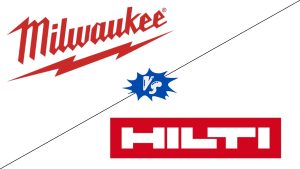When it comes to choosing the right power tools for your construction or DIY projects, it’s essential to consider the top brands on the market. Two such industry leaders in power tools are Hilti and Milwaukee, each with their own unique offerings and advantages. In this article, we will explore the key differences between these two revered brands and help you make an informed decision when purchasing your next power tool.
As you delve into the world of Hilti and Milwaukee, you’ll notice that both brands are renowned for their quality, durability, and performance. However, there are a few distinctions that could sway your choice. It’s worth examining their target markets, product range, and pricing, among other factors, to determine which brand aligns best with your specific needs and preferences.
By understanding the strengths and drawbacks of each brand, you can ensure you’ll invest in the right tools that not only meet your requirements but also provide you with long-lasting value. In the following sections, we will dive deeper into the nuances of Hilti and Milwaukee, comparing their features and capabilities, so you can confidently select the best tools for your projects.
Drills

When comparing Hilti and Milwaukee drills, both brands offer a range of high-quality options to suit your needs. Hilti’s product lines like TE 800-AVR and Hilti SFC 18-A excel in concrete drilling and are well-suited for heavy-duty applications. Milwaukee, on the other hand, has the M18™ and M12™ product lines, which feature powerful cordless drills perfect for woodworking and metalworking tasks.
In terms of productivity, Hilti’s hammer drills generally provide higher impact energy and faster drilling speeds. Milwaukee drills like their M18 FUEL™ line boast of higher RPM and added torque, providing efficient drilling in wood and metal.
Impact Drivers
The impact drivers from both Hilti and Milwaukee offer excellent performance when working on automotive projects and fastening applications. Hilti’s impact drivers, such as the SID 4-A22, deliver impressive torque with a compact design, while Milwaukee’s M18 FUEL™ SURGE™ offers a quieter operation and longer runtime.
| Brand | Model | Torque | RPM |
|---|---|---|---|
| Hilti | SID 4-A22 | 1590 in-lbs | 3200 |
| Milwaukee | M18 FUEL™ SURGE™ | 1800 in-lbs | 3000 |
Saws

Both Hilti and Milwaukee have an extensive range of saws to cater to various cutting applications in wood and metal. Hilti’s saw lineup includes the WSC and SR series, designed for durability and precision in cutting through various materials. Milwaukee’s saw offerings, on the other hand, comprise the M18 FUEL™ and M12 FUEL™ lines, with versatile cordless saws for improved mobility while working.
- Hilti WSC Series: robust corded saws for general cutting
- Hilti SR Series: powerful reciprocating saw
- Milwaukee M18 FUEL™: high-performance cordless saws with extended battery life
- Milwaukee M12 FUEL™: compact cordless saws for tight spaces and precise cuts
Dispensers and Crimpers
In pipe pressing and hydraulic cutting applications, Hilti’s dispensers like the HDM line and Milwaukee’s M18 FORCE LOGIC™ solution both offer reliable performance with advanced features. Hilti dispensers have an innovative design that prevents over-dispensing and reduces waste, while Milwaukee’s crimpers and cutters, such as the M123 FORCE LOGIC™ 600 Mcm Cable Cutter, provide clean and consistent cuts with less effort.
- Hilti HDM Line: precise dispensing with reduced waste
- Milwaukee M18 FORCE LOGIC™: consistent performance in crimping and cutting
Quality and Durability
When it comes to quality, both Hilti and Milwaukee are known for their high standards in manufacturing and design. They utilize advanced technologies in their production processes, ensuring that you receive top-tier tools that can withstand the test of time. With each brand prioritizing durability, you can expect your investment in their products to provide long-lasting value.
In terms of heavy-duty applications, both brands cater to professional users who require tough, reliable tools. Hilti offers products designed explicitly for the construction industry, and their tools are built to withstand the rigors of daily use. Their reputation for manufacturing reliable, durable equipment is well deserved.
Conversely, Milwaukee is also a solid choice if you’re looking for tools that can handle heavy workloads. Known for their toughness and durability, Milwaukee products are suitable for various industries, including automotive, plumbing, and electrical tasks. Regularly improving its offerings, Milwaukee ensures users receive tools that withstand wear and tear.
Ultimately, the choice between Hilti and Milwaukee comes down to your specific needs and preferences. As industry-leading brands, both will provide you with quality, durable, and heavy-duty tools. Carefully consider which brand offers the best products for your specific requirements, and you won’t be disappointed.
Cost Value
When comparing Hilti and Milwaukee tools, it’s important to consider the cost value of each brand. As you explore your options, you’ll find that both brands offer a range of prices to fit different budgets.
Hilti is known for its premium, high-end tools that offer excellent performance and durability. The prices for Hilti tools are generally higher, but you can expect a long-lasting, reliable product. This may be a worthwhile investment if your work demands high-quality tools.
On the other hand, Milwaukee offers a good balance between price and value, with many tools catering to both professional and DIY users. While not as high-end as Hilti, Milwaukee provides a range of options at different price points, making it more accessible to a wider audience.
When determining the best fit for your budget, consider the following factors:
- Price: Compare the prices of similar tools from both brands to identify the differences.
- Value: Assess the features and performance of each tool to gauge how well they meet your needs.
- Longevity: Evaluate the potential lifespan and durability of each tool, taking into account the demands of your work.
By weighing these factors, you can make a more informed decision about which brand offers the best cost value for your specific needs. Remember that the choice ultimately depends on your individual requirements and preferences, as well as the specific tasks you plan to undertake with the tools.




